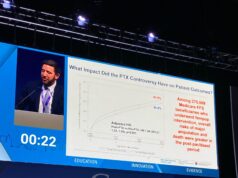
Results from the RELINE trial show that the Viabahn covered stent (Gore) conferred significantly better protection against target lesion revascularisation and had a significantly higher primary patency than percutaneous transluminal angioplasty.
In-stent restenosis is the Achilles’ heel of the current superficial femoral artery treatment. There is some evidence that chemical or drug solutions are valuable in the battle against in-stent restenosis. Now, the RELINE results prove that a mechanical barrier against tissue ingrowth, like the Viabahn stent-graft, is also a promising tool for treatment of in-stent restenosis said Koen Deloose, vascular surgeon AZSB Dendermonde, Belgium.
Deloose was speaking at the Leipzig Interventional Course (LINC; 28–31 January, Leipzig, Germany) and explained that previous trial data had shown that mid-term patency failure in the superficial femoral artery was a complex phenomenon that depended on factors such as lesion length, vessel diameter, lesion location and occlusion vs. stenosis. Further, patient factors such as the presence of end-stage renal disease, diabetes, and sex of the patient also contributed to the development of in-stent restenosis. “Longer lesion definitely seem to have worse outcome with respect to patency and there is more or less 35% of restenosis after one year,” Deloose noted.
With regard to the process by which in-stent restenosis occurs, “Usually vessel treatment leads to endoluminal trauma, followed by the inflammatory response and neointimal proliferation, tissue ingrowth and in-stent restenosis,” Deloose told delegates.
Chemical blocks such as drug-eluting balloons and drug-eluting stents intervene prior to the inflammatory response and inhibit smooth muscle cell migration and proliferation to try and stop this phenomenon. Mechanical blocks such as covered stents create a physical barrier to prevent the inflammatory response and remove the stimulus for in-stent restenosis from the equation, he reported.
The RELINE trial is a physician-initiated, randomised controlled multicentre trial comparing the new generation Viabahn endoprosthesis to percutaneous transluminal angioplasty in the treatment of femoral in-stent restenosis. The participating centres are in Belgium and Germany and the design of the trial was to have 1:1 randomisation with 83 patients (39 to receive the Viabahn endoprosthesis and 44 to receive percutaneous transluminal angioplasty). The primary endpoints were primary patency at 12 months (defined as no evidence of restenosis/re-occlusion within the treated lesion based on colour flow duplex ultrasound (peak systolic velocity ratio ≤2.5) and without target lesion revascularisation within 12 months) and serious device-related adverse events within 30 days post-procedure.
Patients with lesions classified as Rutherford 2–5 and ankle brachial index of ≤0.8 were included. Patients had restenosis/re-occlusion in a stent (implanted>30 days) in the superficial femoral artery with a total target lesion length of 4–27cm comprising in-stent restenosis and adjacent stenotic disease. The baseline patient and lesion characteristics were similar in both arms. In the angioplasty group, mean lesion length was 19cm and in the Viabahn group, it was 17.3cm; 25% of total occlusions were seen in the angioplasty group and 20.6% in the Viabahn group. There was slightly more calcification seen in the group that received covered stents. There were eight bail-out stent procedures performed after failed angioplasty.
At 12 months, investigators saw a 91.9% survival with Viabahn and 95.3% with angioplasty (p=0.383). Twelve-month primary patency with Viabahn was 74.8% vs. 28% with angioplasty (p<0.001). The 12-month freedom from target lesion revascularisation was 79.9% with Viabahn and 42.2% with angioplasty (p<0.001).












